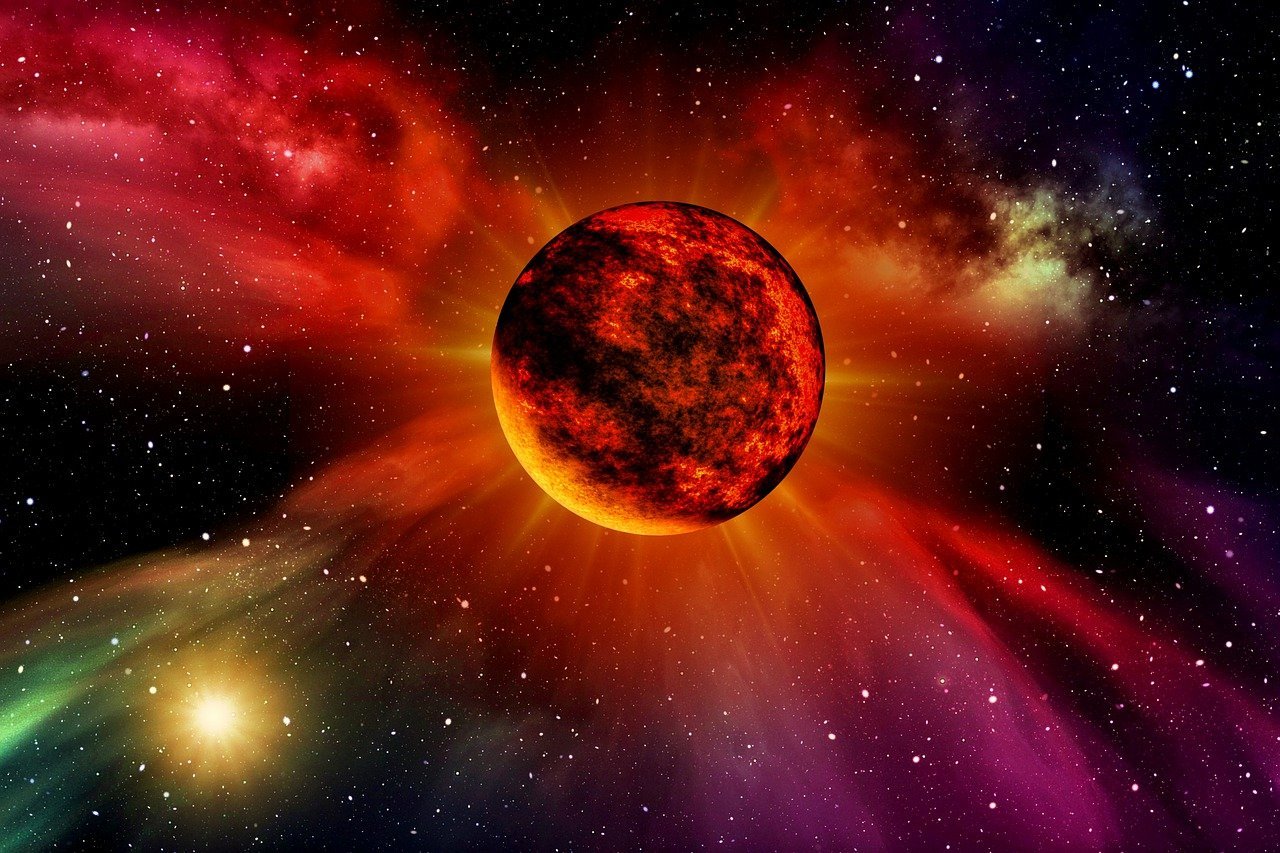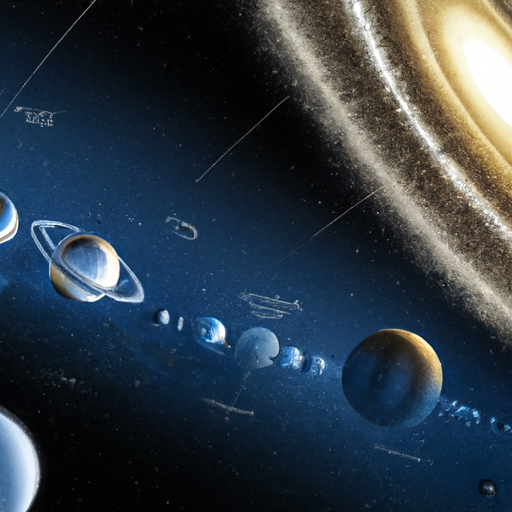Imagine a universe filled with countless planets beyond our solar system, each one with the potential to harbor life as we know it. This is the exciting realm of exoplanets, or planets that exist outside of our own. The search for these distant worlds has captivated astronomers and cosmologists alike, shedding light on the vastness of the cosmos and reshaping our understanding of how planets form and evolve. Join us on a journey through the fascinating world of exoplanets and discover how their discovery is revolutionizing the field of cosmology.

Introduction
The search for exoplanets, planets located outside of our solar system, has revolutionized our understanding of the cosmos. Over the past few decades, advancements in technology and observational techniques have allowed scientists to detect thousands of exoplanets, revealing a diverse range of planetary systems and raising intriguing questions about the origins of life in the universe. This article will explore the fascinating field of exoplanet research and its implications for cosmology.
Understanding Exoplanets
Definition of Exoplanets
Exoplanets, also known as extrasolar planets, are planets that orbit stars other than our Sun. These distant worlds come in various sizes, compositions, and orbital configurations, providing valuable insights into the diversity of planetary systems in the universe.
Discovery Methods for Exoplanets
Detecting exoplanets is no easy feat, considering their remote locations and the overwhelming brightness of their host stars. Scientists have developed several ingenious techniques to overcome these challenges.
One of the most successful methods is the transit method, where astronomers observe a star for slight, periodic dimming caused by a planet crossing in front of it. This technique allows researchers to estimate the size, orbital period, and other characteristics of exoplanets.
Another widely used approach is the radial velocity method, which relies on measuring the tiny wobbles in a star’s motion induced by the gravitational pull of an orbiting planet. By analyzing the Doppler shift of a star’s light, scientists can infer the planet’s mass and orbital distance.
Other detection methods include direct imaging, where telescopes capture the faint light emitted by exoplanets, gravitational microlensing, astrometry, and more. Each method has its strengths and limitations, but together they form a comprehensive toolkit for exoplanet exploration.
Kepler Mission
The Kepler mission, launched by NASA in 2009, revolutionized exoplanet research by observing a single patch of the sky for several years. During its mission, Kepler identified thousands of exoplanet candidates, providing crucial data on their size distribution, orbital characteristics, and frequency in our galaxy. This wealth of information has deepened our understanding of exoplanets and their role in the cosmos.
TESS Mission
Following in the footsteps of Kepler, the Transiting Exoplanet Survey Satellite (TESS) mission, launched in 2018, has continued the search for exoplanets. TESS surveys the whole sky, focusing on nearby stars, and has the potential to discover an unprecedented number of exoplanets, including Earth-sized planets in the habitable zone of their host stars. This mission promises to unveil even more insights into the diversity and prevalence of exoplanets.
Current Exoplanet Catalogs
As the field of exoplanet research advances, scientists compile extensive catalogs of known exoplanets. These catalogs contain essential information such as the planet’s mass, radius, and orbital parameters, aiding in the study of exoplanetary characteristics and the formation of planetary systems. Notable catalogs include the Exoplanet Archive and the NASA Exoplanet Catalog, which are continually updated as new discoveries are made.

Characteristics of Exoplanets
Exoplanetary Composition
Exoplanets come in a wide range of compositions, from rocky worlds like Earth and Mars to gas giants resembling Jupiter and Saturn. By studying the compositions of exoplanets, scientists can gain insights into the formation and evolution of these distant worlds. Data from missions such as Kepler and TESS have revealed that a significant portion of exoplanets found to date are rocky in nature, similar to the terrestrial planets in our solar system.
Exoplanetary Atmospheres
The study of exoplanetary atmospheres is a thriving field, shedding light on the physical properties and potential habitability of these worlds. By utilizing various spectroscopy techniques, scientists are able to analyze the light passing through or reflecting off exoplanetary atmospheres, providing valuable information about their composition. Recent discoveries have showcased the presence of diverse molecules, such as water vapor, carbon dioxide, and methane, in exoplanetary atmospheres, further fueling the excitement for finding potentially habitable planets.
Exoplanet Sizes and Masses
The size and mass of exoplanets play a crucial role in determining their characteristics and formation history. Understanding the distribution of exoplanet sizes and masses provides insights into the processes of planet formation and migration. The discoveries made by Kepler and TESS missions have revealed that exoplanets can range from Earth-sized to massive gas giants, with a significant number falling into the category of “super-Earths” and “mini-Neptunes.” These findings challenge our preconceived notions of planetary systems and offer tantalizing prospects for habitability.
Exoplanet Habitability
One of the most intriguing aspects of exoplanet research is the search for potentially habitable worlds. The concept of habitability revolves around finding conditions conducive to the emergence and sustenance of life as we know it. Factors such as the distance from the host star, composition of the atmosphere, presence of liquid water, and the stability of the planetary environment all contribute to the habitability of an exoplanet. By studying the characteristics of potentially habitable exoplanets, scientists gain valuable insights into the prerequisites for life and the potential for the existence of extraterrestrial life in the universe.
Exoplanets and the Development of Cosmology
Advancements in Cosmological Knowledge
The study of exoplanets has significantly contributed to advancements in our understanding of the cosmos. By expanding our knowledge of planetary systems beyond our solar system, scientists have gained new perspectives on the formation and evolution of planets, the diversity of stellar environments, and the delicate balance required for habitability. These new insights have led to exciting developments in cosmology, pushing the boundaries of our understanding of the universe.
Relevance of Exoplanets to Cosmology
Exoplanets provide a unique opportunity to study the physical processes and conditions that contribute to the formation and evolution of planets. By probing the intricacies of exoplanetary systems and their interactions with their host stars, scientists can gain important insights into the broader processes at play in the cosmos. The study of exoplanets helps to refine and test our models of planetary formation and provides valuable data for the development of cosmological theories.
Understanding Planetary Systems Beyond Our Solar System
The discovery of exoplanets has allowed us to broaden our understanding of planetary systems beyond our own Solar System. The wealth of data gathered from exoplanet missions has revealed a staggering diversity of planetary architectures, with systems consisting of multiple planets orbiting close to their host stars, as well as systems with vast gas giants in wide orbits. These observations challenge traditional models of planetary formation and provide valuable constraints for theories attempting to explain the wide variety of planetary systems found in the universe.
Implications for the Origins of Life in the Universe
One of the most profound questions in science is the origins of life in the universe. The study of exoplanets and their potential habitability has fueled speculation about the existence of life beyond Earth. The discovery of planets with similar characteristics to Earth, such as being within the habitable zone of their host star and having a rocky composition, increases the chances of finding environments suitable for life. While much research is still needed to determine the presence of life on exoplanets, these discoveries encourage scientists to consider the possibility of life existing elsewhere in the universe and its potential implications for our understanding of our own origins.

Theoretical Models and Exoplanet Detection
Planetary Formation Theories
Scientists have developed several theoretical models to explain the formation of planets, both within our Solar System and beyond. These models help explain the diverse array of exoplanetary systems we have discovered. The core accretion model suggests that planets form through the gradual accumulation of material within a protoplanetary disk surrounding a young star. Another model, known as the disk instability model, proposes that some gas giants may form through the direct fragmentation of the disk. By studying the properties of exoplanets, we can test and refine these theoretical models, gaining a better understanding of the processes that shape planetary systems.
Radial Velocity Method
The radial velocity method, also known as the Doppler method, relies on measuring the tiny shifts in a star’s spectrum caused by its gravitational interaction with an orbiting planet. By carefully analyzing the periodic changes in a star’s radial velocity, astronomers can infer the presence of an exoplanet and determine its minimum mass. This technique has been highly successful in detecting massive planets, including some in eccentric orbits. It has played a pivotal role in the field of exoplanet research, and advancements in radial velocity measurements continue to contribute to our understanding of planetary systems.
Transit Method
The transit method, as mentioned earlier, involves detecting exoplanets by observing the slight dips in a star’s brightness as a planet passes in front of it, blocking a fraction of the star’s light. By monitoring these periodic dimming events, astronomers can measure the planet’s size, orbital period, and even some information about its atmosphere. The transit method has been crucial in detecting thousands of exoplanets, including small and potentially habitable worlds. Large-scale transit surveys, such as those conducted by Kepler and TESS, have revolutionized exoplanet research and continue to provide valuable data for further exploration.
Direct Imaging Method
Direct imaging is a challenging but rewarding technique for detecting exoplanets. Instead of searching for the small changes in a star’s light, as in the transit and radial velocity methods, direct imaging attempts to capture the faint glow of an exoplanet itself. This method is particularly useful for detecting young, massive exoplanets at larger separations from their host stars. By analyzing the light reflected or emitted by these exoplanets, scientists can study their atmospheres and physical characteristics. While direct imaging is still in its early stages, ongoing advancements in technology promise to expand our capabilities in studying exoplanets through this method.
Gravitational Microlensing Method
Gravitational microlensing occurs when the gravity of a foreground object, such as a star, bends the light of a more distant object, making it temporarily appear brighter. When the foreground object has a planet, the planet’s gravity can produce additional distortions in the microlensing event. By precisely monitoring these brightness variations, astronomers can detect the presence of exoplanets, including those located at relatively large distances from their host stars. The gravitational microlensing method is particularly sensitive to lower-mass planets and has the potential to unveil a population of exoplanets that may not be effectively detected by other methods.
Astrometry Method
The astrometry method involves measuring the precise motion of a star in the sky caused by the gravitational tug of an orbiting planet. By monitoring the tiny shifts in a star’s position relative to background objects over an extended period, astronomers can infer the presence and properties of an exoplanet. This method is especially effective for detecting massive exoplanets with long orbital periods. Although astrometry measurements are challenging because they require high-precision observations over long time spans, recent advancements in technology and techniques have allowed scientists to successfully detect exoplanets using this method.
Exoplanet Atmospheres and Signatures
Spectroscopy Techniques
Spectroscopy techniques play a pivotal role in the study of exoplanetary atmospheres. By analyzing the light emitted or transmitted through an exoplanet’s atmosphere, scientists can decipher its composition and physical properties. Spectroscopy allows researchers to split the light into its constituent colors and study the unique signatures associated with different chemical compounds. This analytical approach provides valuable insights into the atmospheric makeup of exoplanets and enables the search for potentially habitable environments.
Detecting Atmospheric Composition
The detection of exoplanetary atmospheric composition relies on detecting specific molecules and their associated spectral features. For example, the presence of water vapor in an exoplanet’s atmosphere can be inferred from the unique absorption features it produces in the spectrum. Other molecules, such as carbon dioxide, methane, and oxygen, also leave characteristic imprints in the light spectrum. By comparing these spectral features to laboratory measurements and theoretical models, scientists can identify the chemical composition of exoplanetary atmospheres, helping to unravel their properties and potential habitability.
Evidence of Water Vapor and Other Chemicals
The detection of water vapor in exoplanetary atmospheres has been a significant milestone in the search for habitable worlds beyond Earth. Observations from missions like Hubble and Spitzer have provided compelling evidence of water vapor in the atmospheres of exoplanets, some of which orbit within their star’s habitable zone. Additionally, the discovery of other molecules, such as methane, carbon dioxide, and organic compounds, offers insights into the chemistry and potential for life on exoplanets. These findings enhance our understanding of the conditions necessary for habitability and guide future exploration efforts.
Importance of Atmosphere in the Search for Life
The study of exoplanetary atmospheres is of paramount importance in the search for life beyond Earth. The presence of certain gases, such as oxygen and methane, can be indicative of biological processes. These molecules, known as biosignatures, have the potential to reveal the presence of life on exoplanets. By characterizing exoplanetary atmospheres and identifying these biosignatures, scientists can narrow down their search for potentially habitable and life-supporting exoplanets. The detection of biosignatures would have profound implications for our understanding of life’s abundance and distribution in the universe.

Exoplanet Habitability and the Search for Life
Defining Habitability
Habitability refers to the conditions necessary for life to exist and persist on a celestial body. While defining the precise boundaries of habitability can be complex, several key factors are commonly considered. These include the presence of liquid water, a stable and suitable atmosphere, the right range of temperatures, the availability of essential elements and nutrients, and a stable environment that can withstand external influences. By studying exoplanets within the habitable zone of their host stars and assessing their potential for meeting these criteria, scientists can identify targets of interest for the search for life.
The Goldilocks Zone
The habitable zone, often referred to as the “Goldilocks zone,” is the region around a star where conditions are just right for the existence of liquid water on the surface of an orbiting planet. This zone is defined by the range of distances from the star where a planet’s temperature allows water to exist in its liquid state. Planets too close to their stars will be too hot, causing water to evaporate, while those too far will be too cold, resulting in water freezing. In the search for potentially habitable exoplanets, identifying those within the habitable zone provides a starting point for further investigation into their potential for life.
Detecting Biosignatures
The search for life on exoplanets involves the quest for biosignatures, signs of life that can be detected remotely. These biosignatures include the presence of certain gases, such as oxygen, methane, and other organic compounds, in an exoplanet’s atmosphere. While the detection of biosignatures is challenging, advancements in observational techniques and theoretical models provide hope for future breakthroughs. The upcoming James Webb Space Telescope (JWST), for example, is expected to provide valuable data that could help identify potential biosignatures on exoplanets within its reach.
Implications for the Existence of Extraterrestrial Life
The study of exoplanets has profound implications for the existence of extraterrestrial life. While the discovery of habitable exoplanets does not guarantee the presence of life, it expands our understanding of the conditions that could support life in the universe. The sheer number and diversity of exoplanets found to date, combined with the potential for detecting biosignatures, increase the possibility of finding life beyond Earth. The search for extraterrestrial life is an ongoing and exciting endeavor that pushes the boundaries of scientific exploration and our understanding of our place in the cosmos.
Implications for the Formation of Planetary Systems
Formation of Exoplanetary Systems
The study of exoplanets provides valuable insights into the formation and evolution of planetary systems. By analyzing the diverse array of exoplanetary systems discovered, scientists refine their theories on how planets form, explore the role of protoplanetary disks, and investigate the processes that shape planetary architectures. The data gathered from exoplanet missions, such as Kepler and TESS, challenge traditional models of planet formation and offer new perspectives on the complex interplay of stellar and planetary dynamics during the early stages of a star system’s evolution.
Variety of Planetary Architectures
The discovery of exoplanets has revealed an astounding variety of planetary architectures. Some systems have planets tightly packed in close orbits, resembling our Solar System’s compact inner planets. Others feature large gas giants in wide orbits, occasionally in stark contrast to the modest size of their host stars. The understanding of the wide range of planetary architectures informs our understanding of the conditions and physical mechanisms that give rise to a diverse array of exoplanetary systems. It challenges existing theories and prompts scientists to refine and expand their models of planet formation.
Implications for Our Solar System
Comparing our Solar System to the diverse exoplanetary systems discovered raises intriguing questions about its uniqueness and origins. The prevalence of exoplanets with sizes and characteristics similar to Earth prompts speculation about the potential for habitable environments beyond our own planet. The study of exoplanets, in conjunction with missions exploring our own Solar System, contributes to our understanding of the conditions required for life and provides valuable context for interpreting our own cosmic habitat.
Relationship between Stellar Properties and Planet Formation
The study of exoplanets has revealed a complex relationship between stellar properties and planet formation. The type, size, and composition of a star can significantly influence the formation and characteristics of its planetary system. For example, the abundance of heavy elements in the host star may impact the availability of building blocks for rocky planets. The presence of multiple stars in a system can create intricate dynamics, affecting the formation and stability of planets. By studying exoplanetary systems across a range of stellar properties, scientists can refine their understanding of the complex interplay between stars and planets, shaping our knowledge of planet formation and system evolution.

Astrophysical Implications of Exoplanet Discoveries
Gas Giants and Their Role in Orbital Dynamics
The discovery of numerous gas giant exoplanets has shed light on their role in shaping the dynamics of planetary systems. Gas giants, like Jupiter and Saturn, can exert gravitational influences on smaller, terrestrial planets. These interactions can lead to orbital instabilities, migrations, and even ejections of planets from their original orbits. The presence of gas giants in exoplanetary systems can profoundly impact the formation and long-term stability of potentially habitable worlds. By studying the interactions between gas giants and other planets, scientists gain insights into the complex dance of celestial bodies in dynamic systems.
Migration and Resonances
Planetary migration, the process of planets moving from their original formation locations, has been widely observed in exoplanetary systems. The dynamics of planet migration play a crucial role in shaping the final configuration of a planetary system. Migration can lead to the resonant trapping of planets, where their orbital periods become commensurate, creating stable resonances such as the 2:1 resonance between planets. These resonances can have a profound impact on the stability and architecture of planetary systems. The study of exoplanetary migration and resonances provides valuable data for refining our understanding of how planets form and evolve over time.
Tidal Forces and Orbital Decay
The gravitational interactions between a planet and its host star can result in tidal forces, influencing the orbital evolution and dynamics of exoplanets. These tidal forces can cause the gradual decay of a planet’s orbit, leading to its eventual spiral into the star, a phenomenon known as orbital decay. The detection of exoplanets in close orbits, where tidal forces are most significant, provides insights into the complex interplay between planets and their host stars. Understanding the effects of tidal forces can help refine models of planet migration, orbital decay, and the long-term stability of planetary systems.
Diversity of Planetary Systems
The discovery of exoplanets has undeniably showcased the incredible diversity of planetary systems in the universe. The wealth of data gathered from missions such as Kepler and TESS has revealed systems with a wide range of orbital configurations, planet sizes, and compositions. The unprecedented variety of exoplanetary systems challenges preconceived notions of planetary formation and indicates that our own Solar System may not be a typical planetary system in the cosmos. By studying this diversity and identifying patterns, scientists gain insights into the complex processes that shape and govern the formation and evolution of planetary systems.
Conclusion
The search for exoplanets has revolutionized our understanding of the cosmos, offering a glimpse into the vast diversity of planetary systems beyond our own Solar System. Through the use of innovative detection methods, we have discovered thousands of exoplanets, each with its own unique set of characteristics and implications. Exoplanet research has deepened our understanding of planetary formation, atmospheric compositions, and habitability. Moreover, it has sparked intriguing questions about the origins of life in the universe and the profound implications of our discoveries.
As technology continues to advance and new missions are launched, our knowledge of exoplanets will undoubtedly expand. The upcoming James Webb Space Telescope, along with other future observatories and missions, is poised to uncover even more insights into the multitude of exoplanetary systems. These ongoing efforts will guide us closer to answering fundamental questions about our place in the universe and the potential for life beyond our home planet. The search for exoplanets is an exciting frontier of scientific exploration, offering tantalizing prospects and inspiring us to push further into the unknown.